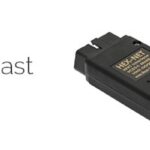Cleaning a Diesel Particulate Filter (DPF) can be a cost-effective alternative to replacement, especially for vehicles like the VW Crafter with known DPF issues. However, simply cleaning the DPF isn’t enough. You need to reset the DPF values in the Engine Control Unit (ECU) using a diagnostic tool like VCDS. This guide will walk you through the process and address common challenges.
Understanding DPF Regeneration and VCDS
DPF regeneration is a process that burns off accumulated soot within the filter. When a DPF becomes excessively clogged, it can trigger warning lights and reduced engine performance. VCDS (Vag-Com Diagnostic System) allows you to access and modify the ECU’s data, including DPF-related parameters. After cleaning a DPF, resetting these values is crucial for proper engine function. This is often mistakenly referred to as a “VCDS DPF delete,” but it’s actually a reset, not a deletion.
Resetting DPF Values with VCDS: Challenges and Solutions
Accessing the necessary adaptation channels within the ECU often requires Security Access. This requires a PIN/SKC code specific to your vehicle. Obtaining this code from the manufacturer can be difficult, as they often restrict access to this information. This poses a significant hurdle for owners wanting to perform maintenance themselves.
Even with Security Access, knowing which values to adjust can be confusing. The “Carbon Mass (ECM/DPF Replacement)” channel in Long Adaptation is key, but interpreting the current readings and calculating the correct “new value” requires understanding specific parameters. For instance, understanding the difference between “Carbon Mass” (total accumulated soot) and “Consumption Since Regen” (soot accumulated since the last regeneration) is vital.
Practical Steps for DPF Reset After Cleaning a VW Crafter
While there isn’t a specific adaptation for “cleaning” a DPF, the process mimics a DPF replacement in terms of resetting values. Here’s a general approach:
-
Clean the DPF: Thoroughly clean the DPF using a reputable cleaner like Wynn’s Off-Car DPF Cleaner. Also, clean related components like the EGR, inlet manifold, and turbo.
-
Gain Security Access: Obtain the PIN/SKC code for your vehicle. This might require persistence with the dealer or exploring alternative solutions within the VCDS community.
-
Access Long Adaptation: Using VCDS, navigate to the Engine Control Module and then to Long Adaptation.
-
Locate “Carbon Mass”: Find the channel for “Carbon Mass (ECM/DPF Replacement).”
-
Resetting the Value: The exact procedure varies depending on the specific ECU. Consult the Ross-Tech wiki for guidance related to your vehicle’s engine code. Generally, you might need to enter a specific value (e.g., “1”) to initiate a reset and then input a calculated “new value” representing the estimated soot accumulation since cleaning. This calculation often involves considering factors like mileage and fuel consumption.
-
Forced Regeneration (Optional): After resetting the values, you might consider performing a forced regeneration using VCDS. This can help ensure the DPF is operating correctly.
Conclusion: Successful DPF Cleaning and Reset with VCDS
Cleaning and resetting your DPF with VCDS can be a viable alternative to costly replacements. While navigating Security Access and understanding the adaptation channels can be challenging, resources like the Ross-Tech wiki and online forums can provide valuable guidance. Remember, accuracy is crucial when modifying ECU values. Always double-check your work and proceed cautiously. A successful reset will result in a properly functioning DPF system and eliminate related error codes.

